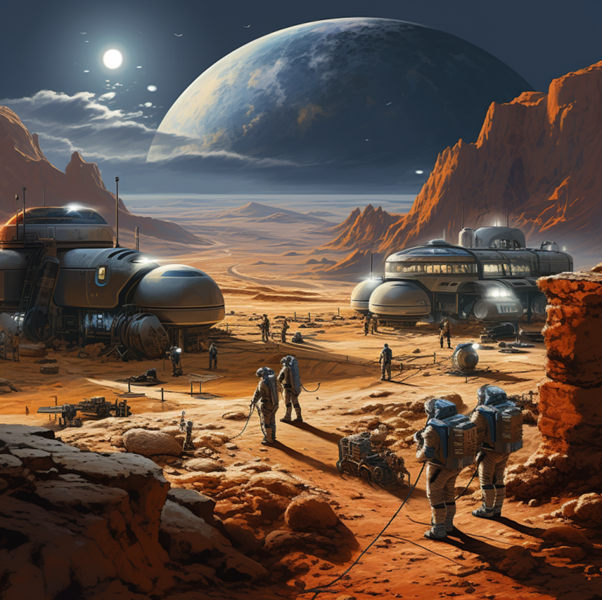Introduction
Since the dawn of humanity, Homo sapiens have demonstrated their extraordinary adaptability and innovation, from leaving Africa 70,000 years ago to exploring the far reaches of space. Today, the dream of human colonization on other planets has become more tangible, with Mars emerging as a prime candidate due to its proximity to Earth, useful resources, and potential for liquid water. In this article, we will delve into the key idea that while Mars holds promise for human colonization, there are numerous challenges and obstacles that must be addressed to make it habitable.
Mars: The Smart Choice for Human Colonization
Elon Musk, the visionary entrepreneur and founder of SpaceX, envisions Mars as the next grand human migration destination. Mars possesses several advantages, making it a smart choice for potential colonization. Its proximity to Earth offers logistical advantages for future missions, allowing for more efficient travel compared to distant celestial bodies.
Furthermore, Mars experiences a day length that is relatively close to Earth’s, which could ease the adaptation of human circadian rhythms and provide a familiar temporal cycle. The Red Planet also boasts an abundance of useful elements, including minerals and metals, that could support human settlements and potential industries. Moreover, the discovery of subsurface ice indicates the possibility of liquid water on Mars, a crucial resource for sustaining life.
Mars’ Challenges: Thin Atmosphere and Extreme Conditions
While Mars holds promise, it presents formidable challenges that must be overcome. Mars’ atmosphere is thin and lacks the protective qualities of Earth’s, making it susceptible to high levels of radiation from space. Additionally, the planet experiences extreme weather conditions, including dust storms that can pose serious threats to human life and infrastructure.
Living on Mars would also have negative effects on the human body, such as muscle atrophy and bone density loss due to the lower gravity. The planet’s frigid temperatures present another obstacle, and the toxic Martian soil would make cultivating crops for sustenance a daunting task.
Elon Musk’s Ambitious Proposals
Elon Musk, the driving force behind SpaceX’s Mars colonization vision, has proposed ambitious ideas to make the Red Planet habitable. One of his proposals involves bombarding Mars with 10,000 nuclear warheads to release trapped carbon dioxide and create a greenhouse effect, eventually warming the planet. However, this plan raises significant issues, as private individuals acquiring nuclear weapons is unrealistic, and the consequences of triggering a nuclear winter could be catastrophic.
Melting Mars’ Ice Caps: A Challenge and Possible Solution
Melting Mars’ ice caps to release water and create a more habitable environment is a daunting task. One idea suggests using a giant mirror in orbit to concentrate sunlight onto the ice cap, accelerating the melting process. However, the construction and deployment of such a massive mirror currently pose technical and financial challenges.

Terraforming Mars’ Atmosphere with Chlorofluorocarbons (CFCs)
Another bold proposition to terraform Mars involves thickening its atmosphere using chlorofluorocarbons (CFCs). This approach could trigger a greenhouse effect, raising temperatures and potentially releasing CO2 from the polar ice caps. Furthermore, the creation of an artificial magnetosphere through CFCs could protect the planet from harmful solar radiation and solar wind.
Overcoming Atmospheric and Nutritional Challenges
Scaling up the conversion of Martian CO2 into oxygen presents significant challenges. Nevertheless, introducing oxygen-producing microorganisms and hardy plant species could enhance surface conditions on Mars. Nonetheless, the scarcity of nitrogen remains a concern for sustainable agriculture.
To address the nitrogen scarcity, scientists propose importing nitrogen from asteroids or Saturn’s moon Titan. However, the implementation of such a complex and risky operation poses immense technical hurdles.
An alternative solution is to construct artificial habitats on or beneath the Martian surface. These habitats could provide a controlled environment for human habitation, addressing the challenges of Martian living.
Elon Musk’s Vision for a Mars City
Elon Musk’s ambitious goal of establishing a self-sustaining Mars city with a population of one million by 2050 is no small feat. While the vision is captivating, it faces numerous obstacles, primarily the staggering cost of such an endeavor. Additionally, uncertainties surround the possibility of human migration to Mars due to potential catastrophic events, such as technical failures during the journey or unforeseen challenges after settlement.
Conclusion
Mars, with its proximity, resources, and potential for water, is undoubtedly an enticing destination for human colonization. However, as we have explored in this article, there are numerous obstacles that must be tackled before we can truly call it a habitable second home for humanity. From overcoming the thin atmosphere and extreme conditions to developing sustainable terraforming methods, the challenges are immense.
While Elon Musk’s vision for a thriving Mars city is captivating, it requires bold innovations, substantial investments, and global cooperation to make it a reality. Ultimately, our journey to Mars will be one of the greatest tests of human ingenuity and determination, as we strive to make the Red Planet a viable outpost for future generations.


